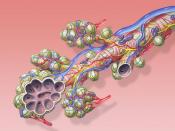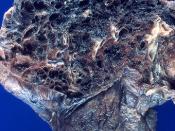Emphysema Human lungs contain 300 million alveoli, or tiny elastic air sacs, through which oxygen is added to the blood and carbon dioxide is removed. When the alveoli lose their natural elasticity, become overstretched, or rupture, emphysema may occur. Several adjacent alveoli may rupture, forming one large air sac that is less able to exchange oxygen and carbon dioxide than a series of smaller sacs is. This causes the airflow in and out of the lungs to significantly slow down. In turn, breathing becomes more rapid, shallow and difficult, particularly in getting air out of the lungs.
Smoking is the major cause of emphysema. In fact, nearly 85% of all the cases found have been among cigarette smokers in their 50s or 60s, however, cigar and pipe smokers are also at risk. It has been found that tobacco smoke may damage the elastic fibers that make up the walls of the alveoli cells.
This loss of elasticity leads to the retention of air in the lungs, expansion of the rib cage, and the flattening of the diaphragm. Normally, through contraction and relaxation, the diaphragm does most of the work when it comes to breathing. But when it remains flattened due to the effects of the smoke on the alveoli, muscles in the rib cage and abdomen take over the bulk of the work. Greater reliance on these muscles is a less efficient and more tiring way of breathing.
Emphysema can also be contracted through genetics. An inherited deficiency of a protein known as alpha1-antitrypsin (ATT), which protects the lungs from destructive enzymes, also can cause emphysema, especially in people younger than fifty. Cases of hereditary emphysema are rare but are still a cause for concern.
The most common symptoms of emphysema are shortness of breath, weight loss, and chronic,


